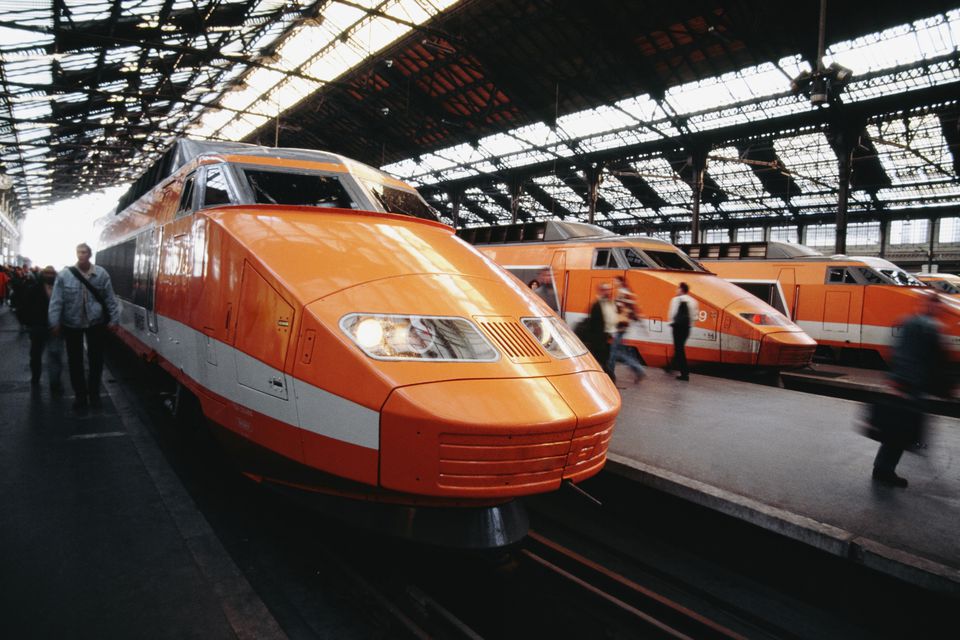History: The TGV (French: Train à Grande Vitesse, "high-speed train") is France's intercity high-speed rail service, operated by the SNCF, the national rail operator. It was developed in the 1970s by GEC-Alsthom and the SNCF. Originally designed as turbotrains to be powered by gas turbines, TGV prototypes evolved into electric trains with the 1973 oil crisis. Following the inaugural service between Paris and Lyon in 1981 on the LGV Sud-Est (LGV for Ligne à Grande Vitesse; "high-speed line"), the network, centred on Paris, has expanded to connect main cities across France (Marseille, Lille, Bordeaux, Strasbourg, Rennes) and in adjacent countries on combinations of high-speed and conventional lines.
A TGV test train set the record for the fastest wheeled train, reaching 574.8 km/h (357.2 mph) on 3 April 2007. In mid-2011, scheduled TGV trains operated at the highest speeds in conventional train service in the world, regularly reaching 320 km/h (200 mph) on the LGV Est, LGV Rhin-Rhône, and LGV Méditerranée. Trains running from Paris to Marseille and Strasbourg can also reach 350 km/h (220 mph). According to Railway Gazette International reports in 2007, the world's fastest scheduled rail journey was a start-to-stop average speed of 279.4 km/h (173.6 mph) between the Gare de Champagne-Ardenne and Gare de Lorraine on the LGV Est, not surpassed until Railway Gazette International's 2013 reported average of 283.7 km/h (176.3 mph) express service on the Shijiazhuang to Zhengzhou segment of China's Shijiazhuang–Wuhan high-speed railway.
The commercial success of the first LGV, the LGV Sud-Est, led to an expansion of the network to the south (LGV Rhône-Alpes, LGV Méditerranée, Contournement Nîmes – Montpellier), and new lines in the west (LGV Atlantique, LGV Bretagne-Pays de la Loire and LGV Sud Europe Atlantique), north (LGV Nord and LGV Interconnexion Est), and east (LGV Est). Eager to emulate the TGV's success, neighbouring countries Italy, Spain, and Germany developed their own high-speed rail services. The TGV system itself extends to neighbouring countries, either directly (Italy, Spain, Luxembourg, Germany and Switzerland) or through TGV-derivative networks linking France to Belgium, Germany, and the Netherlands (Thalys), as well as France and Belgium to the United Kingdom (Eurostar). Several future lines are planned, including extensions within France and to surrounding countries. Cities such as Tours have become part of a "TGV commuter belt" around Paris. In 2007, the SNCF generated profits of €1.1 billion (approximately US$1.75 billion, £875 million) driven largely by higher margins on the TGV network.
From Wikipedia
A TGV test train set the record for the fastest wheeled train, reaching 574.8 km/h (357.2 mph) on 3 April 2007. In mid-2011, scheduled TGV trains operated at the highest speeds in conventional train service in the world, regularly reaching 320 km/h (200 mph) on the LGV Est, LGV Rhin-Rhône, and LGV Méditerranée. Trains running from Paris to Marseille and Strasbourg can also reach 350 km/h (220 mph). According to Railway Gazette International reports in 2007, the world's fastest scheduled rail journey was a start-to-stop average speed of 279.4 km/h (173.6 mph) between the Gare de Champagne-Ardenne and Gare de Lorraine on the LGV Est, not surpassed until Railway Gazette International's 2013 reported average of 283.7 km/h (176.3 mph) express service on the Shijiazhuang to Zhengzhou segment of China's Shijiazhuang–Wuhan high-speed railway.
The commercial success of the first LGV, the LGV Sud-Est, led to an expansion of the network to the south (LGV Rhône-Alpes, LGV Méditerranée, Contournement Nîmes – Montpellier), and new lines in the west (LGV Atlantique, LGV Bretagne-Pays de la Loire and LGV Sud Europe Atlantique), north (LGV Nord and LGV Interconnexion Est), and east (LGV Est). Eager to emulate the TGV's success, neighbouring countries Italy, Spain, and Germany developed their own high-speed rail services. The TGV system itself extends to neighbouring countries, either directly (Italy, Spain, Luxembourg, Germany and Switzerland) or through TGV-derivative networks linking France to Belgium, Germany, and the Netherlands (Thalys), as well as France and Belgium to the United Kingdom (Eurostar). Several future lines are planned, including extensions within France and to surrounding countries. Cities such as Tours have become part of a "TGV commuter belt" around Paris. In 2007, the SNCF generated profits of €1.1 billion (approximately US$1.75 billion, £875 million) driven largely by higher margins on the TGV network.
From Wikipedia
Railroad/Company: Alstom is a French multinational company operating worldwide in rail transport markets, active in the fields of passenger transportation, signalling and locomotives, with products including the AGV, TGV, Eurostar, and Pendolino high-speed trains, in addition to suburban, regional and metro trains, and Citadis trams.
Alstom (originally as Alsthom) was formed from a merger between Compagnie Française Thomson Houston and the Société Alsacienne de Constructions Mécaniques in 1928; significant acquisitions included the Constructions Electriques de France (1932), shipbuilder Chantiers de l'Atlantique (1976), and parts of ACEC SA (Belgium, late 1980s). A merger with parts of the General Electric Company plc (UK) formed GEC-Alsthom in 1989; the company became Alstom in 1998 when it split from the Alcatel-Alsthom group (formerly Compagnie Générale d'Electricité); the 'h' was removed from the name to ease pronunciation on international markets.
In 2014, Alstom and General Electric (GE) announced that a US$17 billion (€12.4 billion) bid for the company's power and grid divisions had been made and provisionally accepted. The acquisition was finalised on 2 November 2015, with GE acquiring Alstom's power generation and electricity transmission business (combined as GE Power) leaving the Alstom company operating solely in the rail transport market.
In 2017, Alstom announced a proposed merger with Siemens Mobility of Germany, to be completed in 2018, at which point the company would be called Siemens Alstom. The proposed merger was eventually prohibited by the European Commission.
In February 2020, Alstom announced that it made an offer to acquire Bombardier Transportation division. The proposed acquisition was this time authorized by the European Commission, with minor remedies such as the selling of the Alstom's plant in Reichshoffen (Alsace, France). The acquisition was completed in January 2021, at which point all the former Bombardier Transportation units are operating under the Alstom brand.
Read more on Wikipedia.
Alstom (originally as Alsthom) was formed from a merger between Compagnie Française Thomson Houston and the Société Alsacienne de Constructions Mécaniques in 1928; significant acquisitions included the Constructions Electriques de France (1932), shipbuilder Chantiers de l'Atlantique (1976), and parts of ACEC SA (Belgium, late 1980s). A merger with parts of the General Electric Company plc (UK) formed GEC-Alsthom in 1989; the company became Alstom in 1998 when it split from the Alcatel-Alsthom group (formerly Compagnie Générale d'Electricité); the 'h' was removed from the name to ease pronunciation on international markets.
In 2014, Alstom and General Electric (GE) announced that a US$17 billion (€12.4 billion) bid for the company's power and grid divisions had been made and provisionally accepted. The acquisition was finalised on 2 November 2015, with GE acquiring Alstom's power generation and electricity transmission business (combined as GE Power) leaving the Alstom company operating solely in the rail transport market.
In 2017, Alstom announced a proposed merger with Siemens Mobility of Germany, to be completed in 2018, at which point the company would be called Siemens Alstom. The proposed merger was eventually prohibited by the European Commission.
In February 2020, Alstom announced that it made an offer to acquire Bombardier Transportation division. The proposed acquisition was this time authorized by the European Commission, with minor remedies such as the selling of the Alstom's plant in Reichshoffen (Alsace, France). The acquisition was completed in January 2021, at which point all the former Bombardier Transportation units are operating under the Alstom brand.
Read more on Wikipedia.
Item Links: We found: 1 different collections associated with Rail - Passenger Train - TGV
- Collection N Scale Model Trains: 36 different items.
Item created by: gdm on 2018-04-15 16:53:04. Last edited by Alain LM on 2018-12-27 13:17:00
If you see errors or missing data in this entry, please feel free to log in and edit it. Anyone with a Gmail account can log in instantly.
If you see errors or missing data in this entry, please feel free to log in and edit it. Anyone with a Gmail account can log in instantly.








